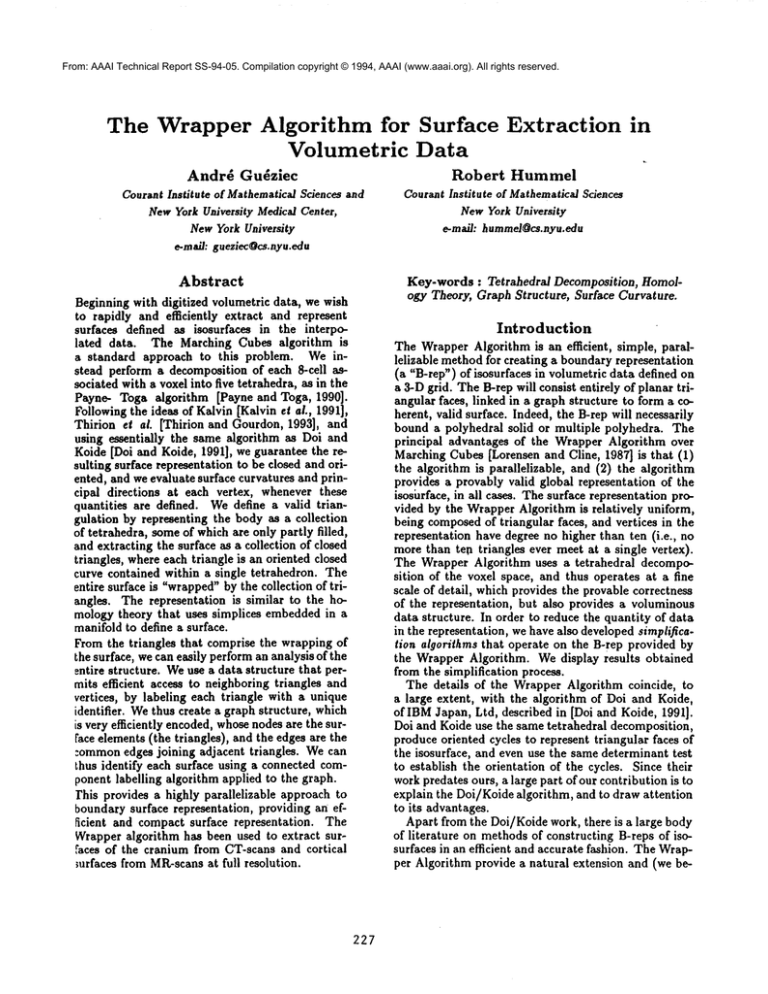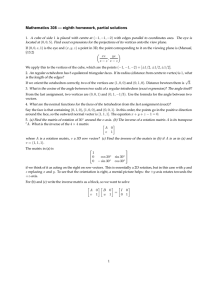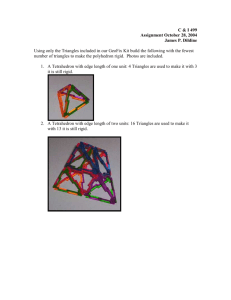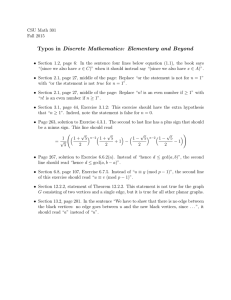
From: AAAI Technical Report SS-94-05. Compilation copyright © 1994, AAAI (www.aaai.org). All rights reserved.
The Wrapper Algorithm for
Volumetric
Andr~
Gu~ziec
Courant Institute of MathematicalSciences and
NewYork University Medical Center,
NewYork University
e.mail: gueziec@cs.nyu.edu
Surface
Data
Extraction
in
Robert
Hummel
CourantInstitute of MathematicalSciences
NewYork University
e-mail: hummel@cs.nyu.edu
Key-words : Tetrahedral Decomposition, Homology Theory, Graph Structure, Surface Curvature.
Abstract
Beginning with digitized volumetric data, we wish
to rapidly and efficiently extract and represent
surfaces defined as isosurfaces in the interpolated data. The Marching Cubes algorithm is
a standard approach to this problem. We instead perform a decomposition of each 8-cell associated with a voxel into five tetrahedra, as in the
Payne- Toga algorithm [Payne and Toga, 1990].
Following the ideas of Kalvin [Kalvin et al., 1991],
Thirion et al. [Thirion and Gourdon, 1993], and
using essentially the same algorithm as Doi and
Koide IDol and Koide, 1991], we guarantee the resulting surface representation to be closed and oriented, and we evaluate surface curvatures and principal directions at each vertex, whenever these
quantities are defined. Wedefine a valid triangulation by representing the body as a collection
of tetrahedra, someof which are only partly filled,
and extracting the surface as a collection of closed
triangles, where each triangle is an oriented closed
curve contained within a single tetrahedron. The
entire surface is "wrapped"by the collection of triangles. The representation is similar to the homology theory that uses simplices embedded in a
manifold to define a surface.
From the triangles that comprise the wrapping of
the surface, we can easily perform an analysis of the
entire structure. Weuse a data structure that permits efficient access to neighboring triangles and
vertices, by labeling each triangle with a unique
identifier. Wethus create a graph structure, which
is very e~ciently encoded, whosenodes are the surFace elements (the triangles), and the edges are the
:ommonedges joining adjacent triangles. Wecan
thus identify each surface using a connected component labelling algorithm applied to the graph.
rhis provides a highly parallelizable approach to
boundary surface representation, providing an ef~cient and compact surface representation.
The
Wrapper algorithm has been used to extract surfaces of the cranium from CT-scans and cortical
mrfaces from MR-scansat full resolution.
Introduction
The Wrapper Algorithm is an emcient, simple, parallelizable methodfor creating a boundary representation
(a "B-rap") of isosurfaces in volumetric data defined
a 3-D grid. The B-rap will consist entirely of planar triangular faces, linked in a graph structure to form a coherent, valid surface. Indeed, the B-rep will necessarily
bound a polyhedral solid or multiple polyhedra. The
principal advantages of the Wrapper Algorithm over
Marching Cubes [Lorensen and Cline, 1987] is that (1)
the algorithm is parallelizable, and (2) the algorithm
provides a provably valid global representation of the
isosurface, in all cases. The surface representation provided by the Wrapper Algorithm is relatively uniform,
being composedof triangular faces, and vertices in the
representation have degree no higher than ten (i.e., no
more than teu triangles ever meet at a single vertex).
The Wrapper Algorithm uses a tetrahedral
decomposition of the voxel space, and thus operates at a fine
scale of detail, which provides the provable correctness
of the representation, but also provides a voluminous
data structure. In order to reduce the quantity of data
in the representation, we have also developed simplification algorithms that operate on the B-rep provided by
the Wrapper Algorithm. We display results obtained
from the simplification process.
The details of the Wrapper Algorithm coincide, to
a large extent, with the algorithm of Doi and Koide,
of IBMJapan, Ltd, described in [Doi and Koide, 1991].
Doi and Koide use the same tetrahedral decomposition,
produce oriented cycles to represent triangular faces of
the isosurface, and even use the same determinant test
to establish the orientation of the cycles. Since their
work predates ours, a large part of our contribution is to
explain the Doi/Koide algorithm, and to draw attention
to its advantages.
Apart from the Doi/Koide work, there is a large body
of literature on methodsof constructing B-reps of isosurfaces in an efficient and accurate fashion. The Wrapper Algorithm provide a natural extension and (we be-
227
lieve) improvement on other methods. While problems
with the Marching Cubes algorithm have largely been
addressed and fixed [Nielson and Hamann, 1991], the
Wrapper Algorithm, with its appeal to homology theory for provable correctness, provides a much simpler
and intuitive approach to surface representation. The
Wrapper Algorithm also provides an orientation of the
surface without additional cost. Although the Wrapper
Algorithm operates at a finer scale and provides a more
detailed representation, which can be disadvantageous,
it provides a more uniform platform for representation
simplification, and can be viewed as a decomposition of
Marching Cubes (and other methods) to a finer scale
so as to makeall the special cases and difficult surface
topologies within a single voxel break up into small collections of simple cases.
Starting with a 3-D image, that is a regular grid
of volume elements representing the sampling of an
intensity function I(z, y, z), we examine the problem
of constructing a polygonal approximation to the surfaces characterized by I = I0, a constant value. This
problem is also knownas implicit surface tiling, for
I(z, y, z) = I0 is an implicit equation for a surface
three-space, or as isoserface construction, since an approximation to an iso-level surface is generated. Cline
and Lorensen (ibid) developed "Marching Cubes" which
partitions the space into cubical elements composedof
eight neighboring voxel values. Inside each of these
cells, a decision is madeas to whether the surface intersects the cell, in which case a polygon approximating
this intersection is constructed. The original algorithm
exploited a symmetrybetween situations involving positive and negative voxel values. It turns out that some
of the polygonal representations so obtained are not
valid, i.e., there are "holes" in the surface. The basic
reason for this is that someconfigurations of positive
and negative voxel values are ambiguous. For example,
on a square face of a cube, whentwo vertices diagonally
opposite are positive and the other two negative, two
different polygonalizations are possible.
Several methods have been proposed to cope with
ambiguous configurations,
without creating holes.
Wallin [WaUin, 1991] suggests using an interpolated
voxel value at the center of the face, in order to choose
one polygonalization or the other. The polygons he defines in each cell can have up to 12 edges. They may
not be trivially triangulated.
Kelvin (ibid) developed another method for disambiguation by selecting a preferred polarity. Then, by
using 6-connectivity in the volume, and 26-connectivity
for the exterior, the key observation is that positive vertices cannot be connected along diagonals, the
decomposition to the right is the one always performed). Kelvin proves that the surfaces produced
are valid. He uses the "Winged Edge" data structure [Baumgart, 1974] to represent and manipulate the
surfaces, and builds them up sequentially, by applying
a succession of surface construction operators.
228
Figure 1: Decompositionof the cube into five tetrahedra.
Four are right isoscele and thus isomorphic(only two are
shown
hereOnBveathe
left), thefifth oneis eqo~lilateral(right).
A!
Figure
vii
2:
(A1, VII,//12,
Tetrahedron
vii
# 1 is
A!
spanned
by
~13)
Thirion (ibid) defines cycles in each voxel, similarly
to Wallin, and shows that the cycles can be oriented.
Further, he introduces oriented segments inside the cycles and a method, "Marching Lines" to draw characteristic
lines on isosurfaces.
The observation by
Monga[Mongaet el., 1992], that it is possible to compute surface curvatures from the discrete differentiation
of voxei values, plays a central role in the Thirion work.
Marching lines has been applied to the problem of registering 3-D medical images [Ayache et al., 1993].
Description
of the wrapper
algorithm
Tetrahedral
Decomposition
Weregard voxels as being values defined at points of a
rectangular lattice, and eight adjacent voxels are taken
to form the 8 vertices of an 8-ceU, or cube. Weuse the
same tetrahedral decomposition as Doi and Koide (see
Fig. 1).
For any given cube, two such tetrahedral decompositions are possible, one which is mirror symmetric with
respect to the y-z plane to the other. In order to be consistent between neighboring 8-cells, i.e., in order that
faces and edges of tetrahedra in one cell match faces
and edges of tetrahedra in the neighboring cells, we
must alternate between the two decompositions from
cell to cell. One type of cell we call an even cell, and
the other type is a odd cell. Even and odd cells are composed in a checkerboard fashion. Within each 8-cell, the
five tetrahedra are numberedfrom one to five in a consistent way. Any given tetrahedron can be described by
either the cell number and tetrahedron number, or by
its four vertices (vt, v2, vs, v4).
Intersection
of Surfaces
with Tetrahedra
The next step consists in determining whether a portion of the isosurface will intersect a given tetrahedron
,1,v2, vs, v4). The intensity values (11,12,13,14) cor.sponding to the four vertices (Hounsfield numbers in
le case of X-ray ComputedTomography)are retrieved
om the 3D image.
Supposing I < 10 at a vertex, we will assume that the
~rtex lies outside the body boundedby the isosurface.
I _~ I0, then the vertex lies inside the body. If the
.~rtices of a tetrahedron are of mixedsign with respect
,10, then the isosurface will intersect the tetrahedron.
ur first task is to determine the points of intersection
ong the edges of the tetrahedron. The location of
,ese points depends on the interpolation function that
1
1o
Figure 3: Defining one or two oriented triangles.
VO
/12
used.
For each edge that exhibits an intensity sign change,
will create a vertex of the polygonal approximation
, the isosurface I -" I0. The exact position of the
.rtex is determined by the zero-crossing of a function
terpolating intensity values along the edge. Our experace shows that using linear interpolation along each
!ge results in a poor result, with excessive spikiness of
e surface. Weinstead choose a bilinear function that
terpolates the four intensity values at the corner of
ch face in the original volumetric grid. This allows
to evaluate values on the faces of the 8-cells; we will
~ver need to explicitly evaluate values internal to the
cells. The bilinear interpolation reduces to linear inrpolation along the edges of an 8-celt, but results in a
ladratic interpolation along diagonal edges on a 8-cell
ce. Specifically, if (a, b, e, d) denote the four intensity
lues on the face of an 8-cell then the intensity value
~ng the (a, d) diagonal edge is given by:
I(u) = (a -6 d - b - c)u2 -6 (-2a -6 b -6 e)u ÷ a.
.~re u varies from 0 to 1 linearly along the diagonal.
ovided ad < 0, I will have exactly one zero in the
nge 0 < u < 1, which can easily be determined from
e quadratic formula (the other zero falls outside this
nge). Having established the interpolation function
>ng tetrahedral boundaries, we can thus compute the
¯ .ations of the intersections of the isosurface with those
ges.
Consider a tetrahedron (U1,1,~2,~3,1,’4)
which is deed by the ordered tuple of vertices spanning the vob
ae. The order is as determinedby one of the five steps
,m section . The corresponding intensity values are
/en by a four-tuph (/1, Is,/3, 14). If all four values
ve the same sign, then the surface does not intersect
.- tetrahedron. If the signs are mixed, however, we
.-n have three major cases. AmongIt,/2,/3,14,
there
.~ either one, two or three positive values. These cases
illustrated in Figure 3. For the cases I and lII, three
the values have the same sign, and the surface inter:ts the tetrahedron on three faces, corresponding to
faces containing the vertex with the opposite sign.
r Case II, two vertices are positive and two are neg.re. In this case, the surface will intersect all four
:es, and we have a quadrilateral. By choosing arbiLrily a diagonal of the quadrilateral, we obtain two
229
Figure 4: The neighbors of an oriented triangle t are numbered suchthat t and no sharethe edge(vo, vl).
triangles within the tetrahedron. Combiningall cases,
we have the surface decomposedinto either one or two
triangles if it intersects the tetrahedron. Anorientation
for a triangle is given by a cycle, or an ordering of the
edges, such that viewed from the outside, the triangle
is traversed in a counter-clockwise direction.
Determining
the orientation
Providing the orientation of each triangular patch is
determined correctly, then the resulting surface representation consists of a collection of oriented cycles. For
any given edge, there are exactly two cycles that traverse the edge. The orientation of the cycles will be
such that the edge is traversed in opposite directions
by the two cycles.
We have developed two methods to determine the
correct orientation of the cycle generated by a tetrahedron. One method, also used by Doi and Koide, uses a
determinant of the positions of the vertices of the tetrahedron, ordered according to the signs of the values at
the vertices, to either reverse or leave alone a cycle. The
other method precompiles all possibilities,
and uses a
bit code pattern determined by the sign of the vertices,
together with two cases depending on whether the 8cell is even or odd. Once the three vertices forming
an oriented triangle (see Fig. 4) have been processed,
the triangle is stored as three pointers to the vertices,
such that the (:v, y, z) coordinates of a given vertex
are physically represented only once.
Experimental
Results
We applied the Wrapper, followed by a simplification algorithm not detailed here, to the representation of the cranium in a CT scan (courtesy of Court
Cutting, NYU), for a pathological -namely, Crouzon
syndrome- case. the result is illustrated in Fig. 5. We
Figure 5: Surface of the craniumfor a Crouzonsyndrome
(100Kverticesand 205Ktriangles), extracted from a 256
by 256 by 150 CTscan. Beforesimplification, the original number
of triangles was1.800K.Themaximum
error
bo.ndis 1.0 millimeter.
extracted the cortical surface of a normal individual
from a MRscan (courtesy of Henry Rusinek, NYU).
The result is in Fig. 6.We acknowledge Gregoire Me,
landain [Malandainet ai., 1993], for pre~processing the
MR-scan.
References
[Ayache et el., 1993] N. Ayache, A. Gudziec, J.P.
Thirion, and A. Gourdon. Evaluating 3D registration of CT-scan images using crest lines. In SPIE,
Mathematical Methods in Medical Imaging I[, volume
2035-06, pages 60-71, July 14-15 1993. San Diego.
[Baumgart, 1974] B.G. Baumgart. Geometric Modeling for Computer Vision. PhD thesis, Stanford University, 1974.
Figure 6: Cortical surface of the brain for a normal individual (3!K vertices and 62Ktriangles), extracted from
256 by 256 by 130 MRscan, Before simplification, the
original numberof triangles was370K. Someimportant
structures stand out, suchas the Inter-HemispheralFissure, the TemporalLobe, the Rolandic Fissure and the
Middle TemporalSulcus,
3d surface construction algorithm. In ACMSiggraph,
volume 21(4), pages 163-169, July 1987. Anaheim.
[Malandain el el., 1993] G. Malandain, N. Ayache, and
G. Bertrand. Topological segmentation of discrete
surfaces. [nria, 10(2):183-197, 1993.
[Monga et el., 1992] Olivier Monga, Serge Benayoun,
and Olivier D. Faugeras. Using third order derivatives to extract ridge lines in 3-D images. In Proceedings of the IEEE Conference on Vision and Pattern Recognition, Urbane Champaign, June 1992.
[Nielson and Hamann, 1991] G.
Nielson
and B. Hamann. The asymptotic decider: resolving the ambiguity in marching cubes. In IEEE Conf.
on Visualization, pages 83-91, 1991.
[Payne and Toga, 1990] B.A. Payne and A.W. Toga.
Surface mapping brain function on 3-D models.
IEEE Computer Graphics ~ Applications, 10(5):3341, September 1990.
[Doi and Koide, 1991] Akio Dot and Akio Koide. An
effcieat method of triangulating equi-valued surfaces by using tetrahedral cells. IEICE 2¥ansactions,
E74(1):214-224, January 1991.
[Thirion and Gourdon, 1993]
J.P. Thirion and A. Gourdon. The marching lines
algorithm: new results and proofs. Technical Report
1881, INR1A,1993.
[Wallin, 1991] Ake Wallin. Constructing isosurfaces
from ct data. IEEE Computer Grapl~ics ~ Applications, U(6):28-33, November1991.
[Kalvin et eL, 1991] A.D.
Kelvin,
C.B.
Cutting, B. Haddad, and M.E. Noz. Constructing
topologically connected surfaces for the comprehensive analysis of 3d medical structures. In SPIE, Proc.
Medical Imaging V: Image Processing, volume 1445,
pages 247-258, October 1991. Bellingham, Wash.
[Lorensen and Cline, 1987] William E. Lorensen and
Harvey E. Cline, Marching cubes: A high resolution
230





